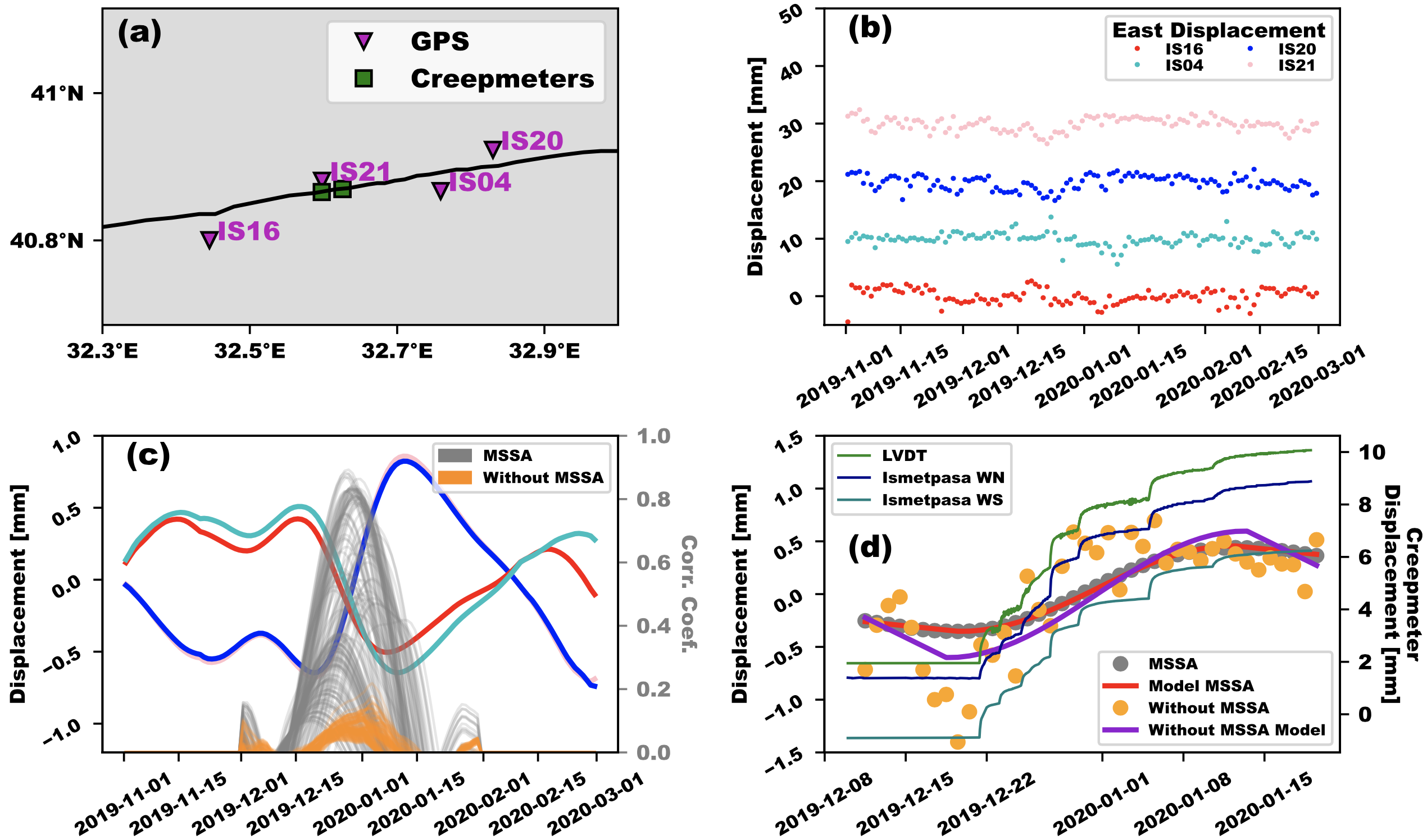Aseismic slip across the EQ cycle
Seismogeodetic exploration of the EQ Preparation Phase
The mechanisms leading to EQs remain debated between the cascade and preslip models. The first proposes that a cascading sequence of foreshocks triggers the mainshock by stress transfer. The second suggests that a slow aseismic slip accelerates and degenerates into a large EQ. During my career, I have been interested in using seismogeodesy to evaluate the significance of aseismic slip in such a debate.
For instance, by studying the Mw 8.1 Iquique EQ in northern Chile, we have detected a westward acceleration lasting eight months before the mainshock and an 80% aseismic compared with seismological data. Two weeks before the mainshock, a Mw 6.7 EQ occurred, and a large transient was detected by GNSS (35% aseismic). We got similar results for the Mw 6.9 Valparaiso EQ (Central Chile), where we investigated the impact of seismic and aseismic slip during the preparation phase, accounting for uncertainties in the observations and models. GNSS observations show a westward motion starting three days before the mainshock. By comparing with seismological data, we estimate that 51% of the displacement measured by GNSS data originates from aseismic slip on the megathrust. Such observations confirm that aseismic slip on the subduction interface plays an essential role in the EQ preparation phase.
These results are very relevant because the traditional definition of a seismic gap considers the recurrence time between EQs in a given region, considering only the along-strike segmentation and not the event location at depth. Our results demonstrate that seismogenic zones are also segmented along-dip. This feature must be considered for a more reliable EQ hazard assessment, which is also supported by analysis of historical catalogs. Additionally, such results describe the importance of fault geometrical complexities in the EQ rupture process along subduction settings and, thus, its link with tectonics.
Slab role in the EQ Triggering and Preparation Phase
Recent studies suggest that a triggering link exists between intermediate-depth seismicity and the occurrence of megathrust EQs. The reduced magnitude of this precursory seismicity makes direct triggering unlikely but suggests a wider slab deformation or plunge leading to a megathrust rupture. In 2005, the Mw 7.8 Tarapaca slab-pull EQ occurred in the same latitude range as the Iquique EQ in 2014. Using seismogeodetic observations, we have observed a broad change in the surface deformation following the Tarapaca EQ, as well as an increase in background seismicity depth interactions. Such observations suggest an aseismic decoupling of the subduction interface triggered by the Tarapaca EQ, and produced by the slab, potentially leading to the occurrence of the Iquique EQ years later.
Regarding the interaction/triggering between EQs at long distances, three significant events occurred in the Chilean subduction zone between 2010 and 2015. Seismic catalog analysis of the Mw 8.4 Illapel EQ supports the idea that the Maule and Iquique EQs triggered this event via a deep transient slip propagated by the slab. Such observations suggest that the slab plays a key role in the EQ triggering and preparation phase. Our findings demonstrate that the slip rates at depth in subduction zones change over time by spreading deformation on a large spatio-temporal scale (not included in the EQ cycle models), ultimately affecting interface processes.
The false quiescence of the Interseismic Phase
Interseismic coupling maps are used to investigate the locking degree on faults over a period between two megathrusts EQs, revealing heterogeneous patterns on the slip behavior. Areas locked during the interseismic period correlate with EQ rupture areas, whereas those not fully-locked are potentially sliding aseismically either in a steady-state or in a burst-like behavior. Southern Peru - Northern Chile region is a fast subduction (7 cm/yr), that is seismically active and presents a highly along-strike coupling variability. Conversely, the Lesser Antilles is a slow subduction zone (2 cm/yr) with no large interplate EQs and an interface that slides aseismically in the long-term. Although such models provide a good idea of the long-term slip behavior and its relation with tectonics, the question of aseismic slip dynamics (steady-state vs episodic) remains open, with significant implications on our understanding of the physics of fault slip.
This problem has led us to develop methods for aseismic slip event detection, which we applied in the South Peru - North Chile subduction zone and along the central section of the North Anatolian major continental strike-slip fault. We use geodetic template matching (GTM) and Multivariate Singular Spectrum Analysis (MSSA) to detect and characterize events along both faults. These results in Chile and Turkey confirm that bursts of aseismic slip are more frequent than previously thought, requiring careful and detailed data processing and analysis for their detection. These observations ultimately provide better constraints for future numerical modeling of such configurations.

(a) GNSS network in Ismetpasa, Turkey. (b) East GNSS displacement. (c) East PC using MSSA, along with the correlation function from GTM (template 30 days, $M_w$ 4) using MSSA-PC (gray) and raw-data (orange). (d) Event source model using MSSA (gray data, red model) and raw-data (orange data, mangenta model). Results are compared with those provided by creepmeters during the same period.
Relevant publications
An 8 month slow slip event triggers progressive nucleation of the 2014 Chile megathrust
Socquet, A., Valdes, J. P., Jara, J., Cotton, F., Walpersdorf, A., Cotte, N., Specht, S., Ortega-Culaciati, F., Carrizo, D., & Norabuena, E. GRL, 2017 44(9), 4046–4053. doi:10.1002/2017GL073023.
Long-Term Interactions Between Intermediate Depth and Shallow Seismicity in North Chile Subduction Zone.
Jara, J., Socquet, A., Marsan, D., & Bouchon, M. GRL. 2017, 44(18), 9283–9292. doi:10.1002/2017GL075029
Revisiting Slow Slip Events Occurrence in Boso Peninsula, Japan, Combining GPS Data and Repeating Earthquakes Analysis
Gardonio, B., Marsan, D., Socquet, A., Bouchon, M., Jara, J., Sun, Q., Cotte, N., & Campillo, M. JGR: Solid Earth. 2018, 123(2), 1502–1515. doi:10.1002/2017JB014469
Suspected Deep Interaction and Triggering Between Giant Earthquakes in the Chilean Subduction Zone
Bouchon, M., Marsan, D., Jara, J., Socquet, A., Campillo, M., & Perfettini, H. GRL. 2018, 45(11), 5454–5460. doi:10.1029/2018GL078350
Inferring Interseismic Coupling Along the Lesser Antilles Arc: A Bayesian Approach
van Rijsingen, E. M., Calais, E., Jolivet, R., de Chabalier, J. ‐B., Jara, J., Symithe, S., Robertson, R., & Ryan, G. A. JGR: Solid Earth. 2021, 126(2), 1–21. doi:10.1029/2020JB020677
Seismic and Aseismic Fault Slip During the Initiation Phase of the 2017 Mw = 6.9 Valparaíso Earthquake.
Caballero, E., Chounet, A., Duputel, Z., Jara, J., Twardzik, C., & Jolivet, R. GRL, 2021, 48(6), 1–11. doi:10.1029/2020GL091916
Observation of a Synchronicity between Shallow and Deep Seismic Activities during the Foreshock Crisis Preceding the Iquique Megathrust Earthquake
Bouchon, M., Guillot, S., Marsan, D., Socquet, A., Jara, J., & Renard, F. Seismica. 2023, 2(2). doi:10.26443/seismica.v2i2.849.
Daily to centennial behavior of aseismic slip along the central section of the North Anatolian Fault
Jolivet, R., Jara, J., Dalaison, M., Rouet-Leduc, B., Özdemir, A., Doğan, U., Çakir, Z. & Ergintav, S. JGR. 2023, 128(7), 1-35. doi:10.1029/2022JB026018.
Detection of slow slip events along the south Peru - north Chile subduction zone.
Jara, J., Socquet, A., Jolivet, R., Comte, D. & Norabuena, E. Submitted to Seismica.Episodic aseismic slip events along the Central Section of the North Anatolian Fault.
Özdemir, A., Jara, J., Doğan, U., Jolivet, R., Çakir, Z., Ergintav, S., & Bilham, R. G. To be submitted to GRL.
